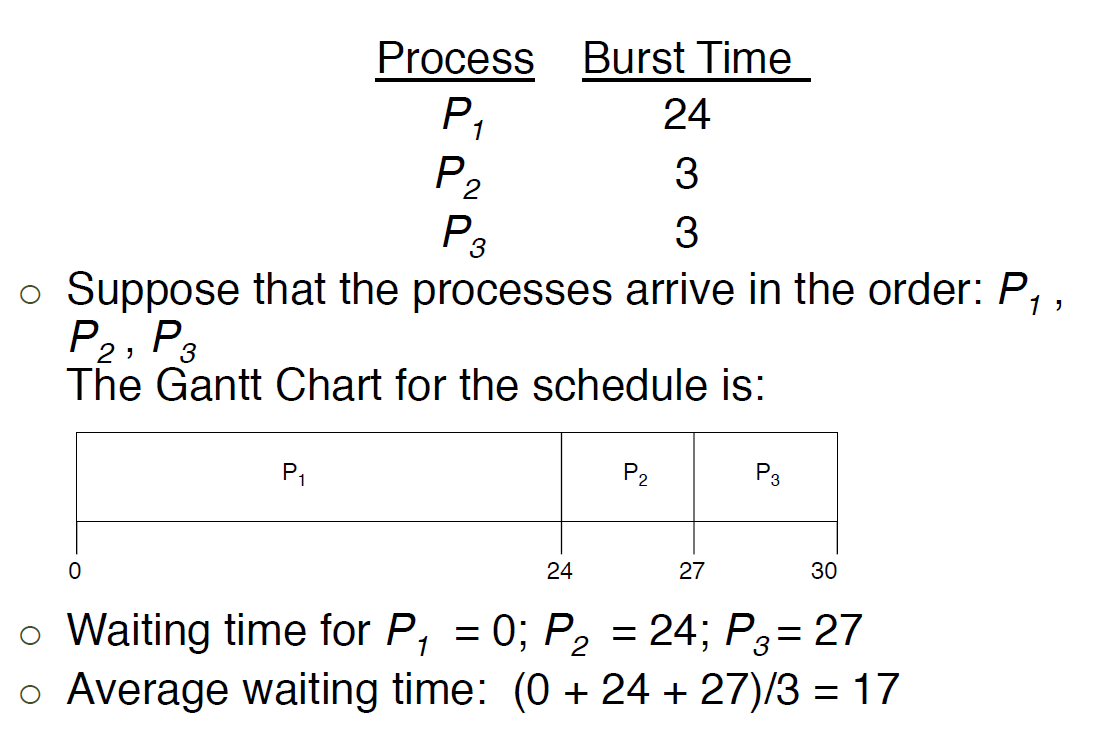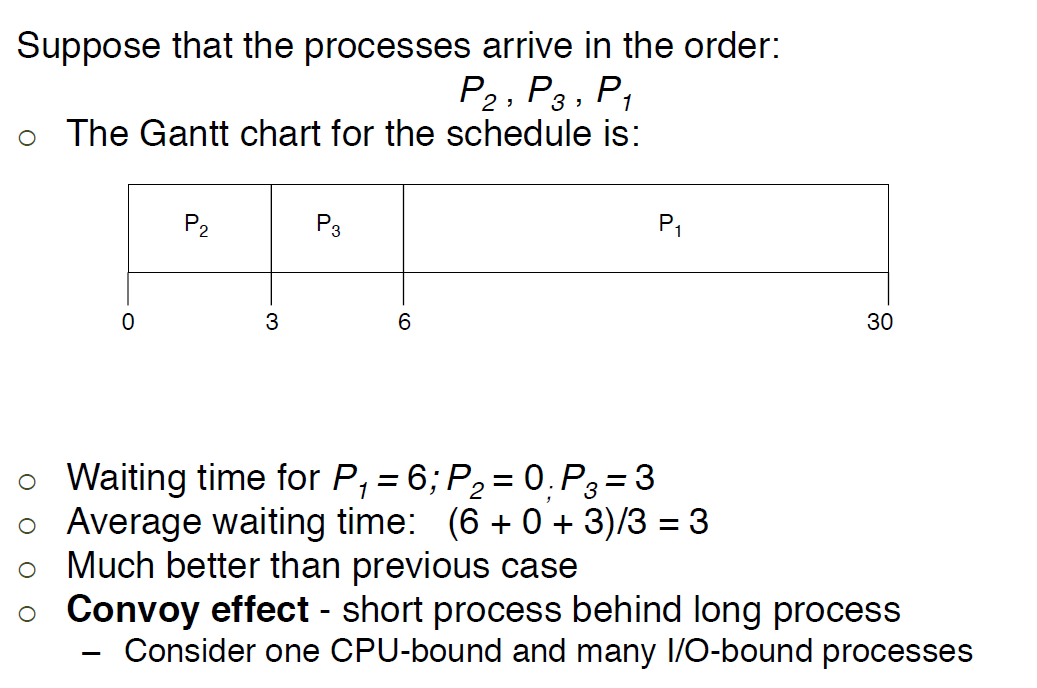- maximum CPU utilization obtained with multiprogramming
- CPU-I/O Burst Cycle- Process execution consist of a cycle of CPU execution and I/O wait
2. CPU Scheduler
- Selects from among the processes in ready queue, and allocates the CPU to one of them
- queues may be ordered in various ways
- CPU scheduling decisions may take place when a process
- switches from running to waiting sate
- switches from running to ready state
- switches from waiting to ready state
- terminate
- scheduling under 1 and 4 is non-preemptive
- all other scheduling is preemptive
- consider access to shared data
- consider preemption while in kernel mode
- consider interrupts occurring during crucial OS activicites
3. Dispatcher
- Dispacher module gives control of the CPU to the process selected by the short-term scheduler; this involves
- switching context
- switching to user mode
- jumping to the proper location in the user program to restart that program
- Dispatch latency
- time it takes for the dispatcher to stop one process and start another running
4. Scheduling Criteria
- CPU utilization
- keep the CPU as busy as possible
- Throughput
- # of processes that complete their execution per time unit
- Turnaround time
- amount of time to execute a particular process
- Waiting time
- amount of time a process has been waiting in the ready queue
5. First-Come. First-Server (FCFS) Scheduling
6. Shortest-Job-First (SJF) Scheduling
- associate with each process the length of its next CPU burst
- use these lengths to schedule the process with the shortest time
- SJF is optimal
- gives minimum average waiting time for a given set of processes
- the difficult is knowing the length of the next CPU request
7. Determine the length of next CPU burst
- can only estimate the length
- should be similar to the previous one
- then pick process with shortest predicted next CPU burst
- can be done by using the length of previous CPU bursts, using exponential averaging
- $t_n$ = average length of the n-th CPU burst
- $\tau_{n+1}$ = predicted value of the next CPU burst
- $\alpha, 0 \leq \alpha \leq (1-\alpha) \tau_n$
- commonly, $\alpha$ set to 1/2
- preemptive version called shortest-remaining-time-first
8. Example of Exponential Averaging
- $\alpha = 0$
- \tau_{n+1} = \tau_n
- recent history does not count
- $\alpha = 1$
- $\tau_{n+1} = n \tau_n$
- only the actual last CPU burst counts
- If we expand the formula, we get
- $\tau_{n+1} = \alpha \tau_n + (1-\alpha) \tau_{n-1} + ...$
- $= (1-\alpha)^j \alpha \tau_{n-j} + ... $
- $= (1-\alpha)^{n+1} \tau_0$
- since both $\alpha$ and $1-\alpha$ are less than or equal to 1, each successive term has less weight than its predecessor
9. Example of Shortest Remaining-time-first
10. Priority Scheduling
- A priority number (integer) is associated with each process
- The CPU is allocated to the process with the highest priority (smaller integer = highest priority)
- preemptive
- non-preemptive
- SJF is priority scheduling where priority is the inverse of predicted next CPU burst time
- Problem = starvation
- low priority processes may never execute
- Solution = aging
- as time progresses, increase the priority of the process
11. Round Robin
- Each process gets a small unit of CPU time (time quantum q), usually 10-100 milliseconds.
- after this time has elapsed, the process is preempted and added to the end of the ready queue
- If there are n processes in the ready queue and the time quantum is q, then each process gets 1/n of the CPU time is chunks of at most q time units at once.
- No process waits more than (n-1)q time units.
- Time interrupts every quantum to schedule next process
- Performance
- q large : FIFO
- q small: q must be large with respect to context switch, otherwise, overhead is too high
- Example of Round robin with time Quantum =4
12. Multilevel Queue
- Ready queue is partitioned into separate queues, e..g,
- forground (iterative)
- background (batch)
- Process permanently in a given queue
- Each queue has its own scheduling algorithm
- forground-RR
- background-FCFR
- Scheduling must be done between the queues
- fixed priority scheduling: i.e., serve all from foreground then from background
- possibility starvation
- time slices: each queue gets a certain amount of CPU time which it can schedule amongst its processes, i.e., 80% to foreground in RR
- 20% to background in FCFS
13. Multi-level feedback queue
- a process can move between the various queues;
- aging can be implemented this way
- multi-level-feedback-queue scheduler defined by the following parameters
- number of queues
- scheduling algorithms for each queue
- method used to determine when to upgrade a process
- method used to determine when to demote a process
- method used to determine which queue a process will enter when that process needs service
- Example of multilevel feedback queue
- three queues
- $Q_0$: time quantum 8 milliseconds
- $Q_1$: time quantum 16 milliseconds
- $Q_2$; FCFS
- scheduling
- a new job enters queue $Q_0$ which is served FCFS
- when it gains CPU, job received 8 milliseconds
- if it does not finish in 8 milliseconds, job is moved to queue $Q_1$
- at $Q_1$ job is again served FCFS and receives 16 additional milliseconds
- if it still does not complete, it is preempted and moved to queue $Q_2$
14. Thread Scheduling
- Distinction between user-level and kernel-level threads
- when threads supported, threads scheduled, not processes
- many-to-one and many-to-many methods, thread library schedules user-level threads to run on LWP
- known as process-contention scope (PCS) since scheduling competition is within the process
- typically thread scheduled onto available CPU is system contention scope (SCS)
- competition among all threads in the system
15. Multi-Processor Scheduling
- CPU scheduling more complex when multiple CPUs are available
- Homogeneous processors within a multiprocessor
- Asymetric multiprocessing
- only one processor accesses the system data structures, alleviating the need for data sharing
- Symmetric multiprocessing (SMP)
- each processor is self-scheduling, all processes in common ready queue
- or each has its own private queue of ready processes
- Processor Affinity
- process has affinity for processor on which it is currently running
- soft affinity
- hard affinity
- variation including processor sets
16. Multiplecore Processor
- recent trend to place multiple processor cores on the same physical chip
- faster and consumes lees power
- multiple threads per core also growing
- takes advantage of memory stall to make progress on another thread while memory retrieve happens









No comments:
Post a Comment